02 June 2022
A look back at the Queen’s royal visits to CWGC sites
Over the years, Her Majesty Queen Elizabeth II has visited many of our sites around the world. Join us for a trip through time, looking at some of the Queen’s most storied CWGC visits.
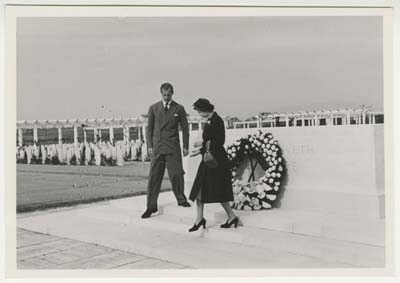
Beach Head and Anzio War Cemeteries, Italy – April 1951
Our first stop takes us to Anzio, Italy, before Her Majesty ascended to the throne. On the afternoon of April 19th, 1951, the then Princess Elizabeth and the Duke of Edinburgh visited the Beach Head (Anzio) and Anzio War cemeteries. Together, these memorials commemorate just over 3,000 servicemen and women, making those that fell during the Italian campaigns of the Second World War.
At what was her first official visit to a Commonwealth site, Princess Elizabeth laid a wreath on the War Stone in the Beach Head Cemetery and made a tour of the two Anzio sites. Before Their Royal Highnesses left, they signed their names in the visitors' books.
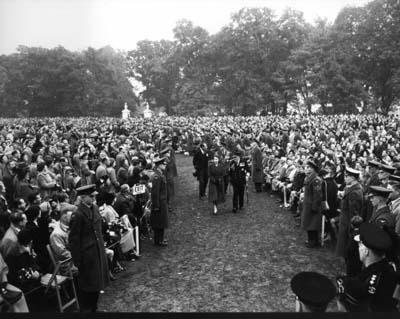
Runnymede Memorial, UK – October 1953
The Queen’s first official visit to a Commission memorial as monarch was the opening of the Runnymede Memorial on Saturday 17th October 1953. 25,000 relatives of the servicepeople memorialised here were in attendance. Her Majesty was shown around Runnymede by Edward Maufe, the Commission’s then Principal Architect.
Runnymede remembers 20,275 men and women of the RAF who lost their lives during the Second World War but have no known grave.
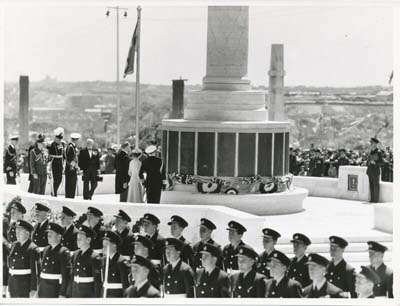
Malta Memorial, Malta – May 1954
The Malta Memorial, dedicated to 2,300 airmen who fought in the Maltese skies, was unveiled by the Queen on May 3rd, 1954, and she has revisited it several times. There are multiple CWGC sites commemorating the men and women of Malta across the island, commemorating thousands of names.
The island’s population suffered through many hardships, including food shortages and lengthy bombing campaigns, across a multi-year siege. Because of their resilience, the Island was awarded the George Cross by King George VI.
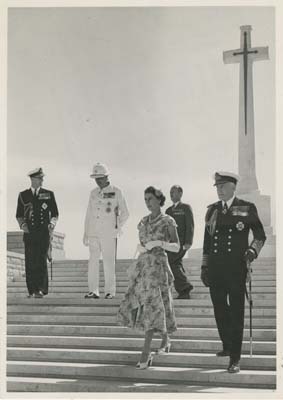
Tobruk War Cemetery, Libya – May 1954
The Queen and the Duke of Edinburgh were on the return leg of their Commonwealth tour when they visited Tobruk War Cemetery, in early May 1954. Her Majesty laid a wreath upon the Stone of Remembrance to commemorate over 2,750 men buried there, victims of the fighting during the Second World War’s North Africa campaign.
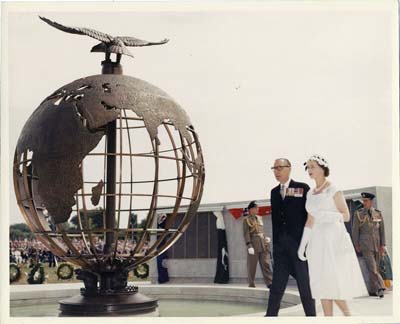
Ottawa Memorial, Canada – July 1959
To commemorate some 800 men and women who lost their lives serving while operating from bases in Canada, The British West Indies, and the United States, the Queen unveiled the Ottawa Memorial on a hot summer's day in July 1959.
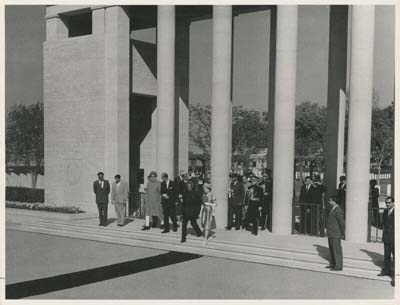
Delhi War Cemetery, India – March 1961
The scope of the Commonwealth War Graves Commission covers all the corners of the globe and the Queen’s tours certainly reflect that. During a trip to India in March 1961, Her Majesty took time to visit Delhi War Cemetery. Over 1,000 Indian army troops are buried here, representing soldiers from the First and Second World Wars.
The Cemetery visit was part of the Queen’s wider tour of India, marking her maiden Indian visit and the first visit for a British monarch post-independence. While in Delhi, Her Majesty laid a wreath at the Mahatma Gandhi Memorial and attended jubilant Republic Day celebrations at Rajpath.
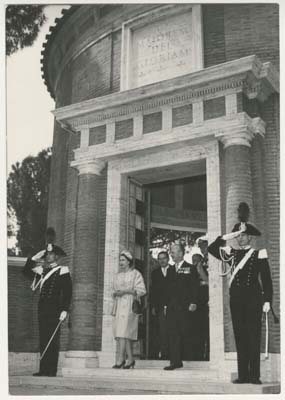
Rome War Cemetery, Italy – May 1961
The Louis de Soissons-designed Rome War Cemetery sits in a suitably picturesque spot beneath the city’s ancient Aurelian Walls. Just over 400 casualties from World War Two’s Italy campaign are buried here. Her Majesty and the Duke of Edinburgh were hosted here by Italian Minister of Defence Giulio Andreotti during a wreath-laying ceremony in May 1961.
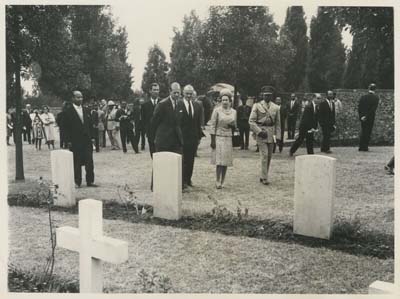
Addis Ababa, Asmara & Khartoum War Cemeteries, Ethiopia, and Sudan
Her Majesty and the Duke of Edinburgh undertook a whistle-stop tour of a trio of East African cemeteries and memorials in February 1965 as part of a state visit to the region. Trips to the Addis Ababa and Asmara War Cemeteries in Ethiopia (Asmara is now the capital of Eritrea) and Khartoum War Cemetery in Sudan were on the agenda. Wreaths were laid as The Queen took time to reflect on sacrifices made by the combined 950 or so casualties these cemeteries collectively commemorate.
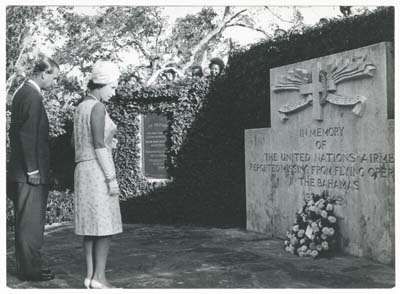
Nassau War Cemetery, The Bahamas – February 1966
The Queen, accompanied by Prince Philip, visited Nassau War Cemetery on 28th February 1966. Relatives of Bahamians who fell in the 1939-1945 War, ex-Servicemen and members of the Imperial Order Daughters of the Empire were among those who attended the ceremony. 51 casualties are buried here, with a further 9 commemorated on the Nassau Memorial.
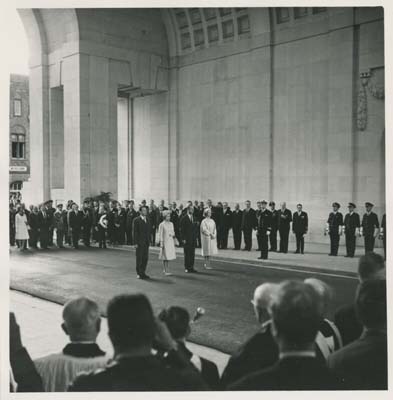
Tyne Cot & Menin Gate, Belgium – May 1966
Fifty years on from the opening salvos on the Somme, The Queen took part in commemorative efforts at Tyne Cot Cemetery and the iconic Menin Gate at Ypres. Roughly 12,000 World War One Commonwealth burials can be found at Tyne Cot. Another 35,000 casualties with no known grave are commemorated on the Tyne Cot Memorial inside the cemetery while the Menin Gate commemorates nearly 55,000 Great War soldiers. King George V chose the spot at Tyne Cot for the Cross of Sacrifice 44 years before the Queen’s visit.
The Duke of Edinburgh accompanied the Queen on this tour of some of the most significant Great War memorials we currently oversee. At each site, Her Majesty laid a commemorative wreath. Her tour also took in the Canadian Memorial at St. Julien and St. George's Memorial Church, Ypres.

Gallipoli, Turkey – October 1971
Gallipoli is forever synonymous with the gallantry and fortitude of the Great War’s ANZAC troops. To pay tribute to the men who fell in the ill- fated Gallipoli Campaign of 1915-1916, the Queen, the Duke of Edinburgh and Princess Anne, visited the Peninsula’s war memorials and cemeteries in October 1971. Her Majesty and Prince Philip laid wreaths at the Turkish and French Memorials at Mono Bay and the Commonwealth Memorials at Helles, Lone Pine and Chunuk Bair.
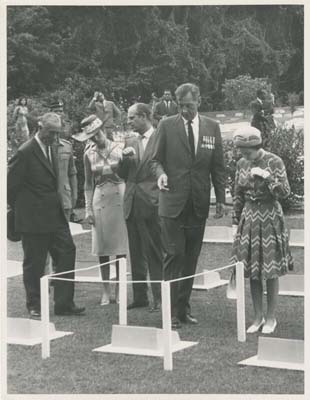
Labuan War Cemetery, Malaysia - February 1972
On 26th February 1972, The Queen, with The Duke of Edinburgh and Princess Anne and Admiral of the Fleet Earl Mountbatten of Burma, visited Labuan War Cemetery, Sabah, Malaysia in February 1972. At the Cross of Sacrifice, Her Majesty and Prince Philip laid a wreath prepared by the Head Gardener, Lim Moi Hong. Just shy of 2,000 Australian Army and Airforce casualties are buried at Labuan. A further 2,300 with no known grave are commemorated at the Labuan Memorial.
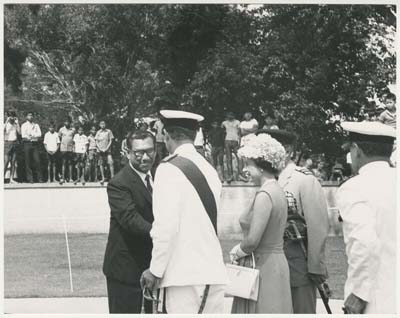
Kranji War Cemetery, Singapore – March 1972
On 5th March 1972, The Queen, with Prince Philip and Lord Mountbatten, visited Kranji War Cemetery and the Singapore Memorial as part of the royal party’s Asian tour. Her Majesty and Prince Philip jointly laid a wreath at the Memorial, and a second was laid by Lord Mountbatten. Kranji War Cemetery marks around 3,700 Commonwealth troops who fought during campaigns in Southeast Asia in World War Two.
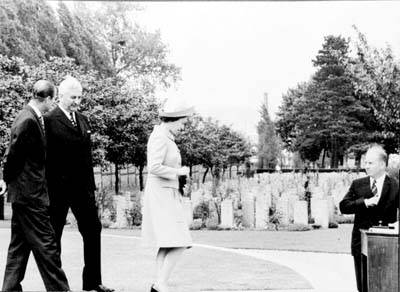
St. Sever Cemetery, France – May 1972
On the final day of the State Visit to France in May, The Queen and Prince Philip, accompanied by the French Prime Minister and other dignitaries, visited St Sever Cemetery and Extension, Rouen, one of our largest French war cemeteries. Together, the Cemetery and Extension commemorates close to 12,000 casualties.
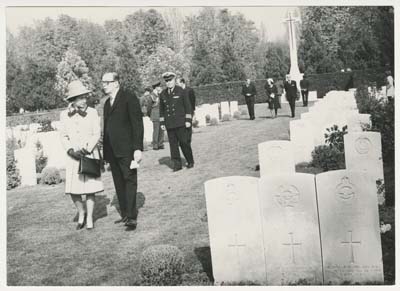
Belgrade War Cemetery, Serbia – October 1972
You may think Belgrade is an odd place for a CWGF War Cemetery, but the Serbian site is the final resting place of nearly 500 Commonwealth servicepeople. Burials here include escaped prisoners of war from the Greece and Italy campaigns of the Second World War, as well as burials from Malta and other theatres of conflict. The Queen visited Belgrade War Cemetery to pay her respects in October 1972.
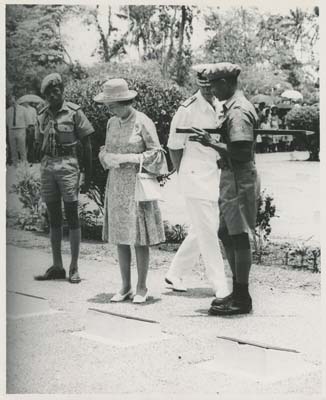
Lae War Cemetery, Papua New Guinea - February 1974
Lae War Cemetery is a great example of the scale of the Second World War. Located in Papua New Guinea, Lae holds over 2,000 Australian army, naval and air force personnel as well as local New Guinean troops who fought in the Pacific Theatre. Her Majesty visited Lae in February 1974 to lay a commemorative wreath, 31 years after fighting on the island had ceased.
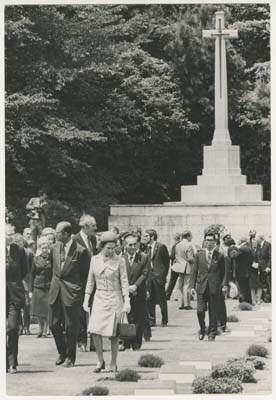
Yokohama War Cemetery, Japan – May 1975
Her Majesty was undertaking a state visit to Japan with the Duke of Edinburgh when she visited Yokohama War Cemetery in May 1975. Including the Cremation Memorial and Memorial, the Commission’s Yokohama sites reflect the multinational effort of World War Two, with close to 2,000 Indian, Australian, New Zealand, and UK troops commemorated here.
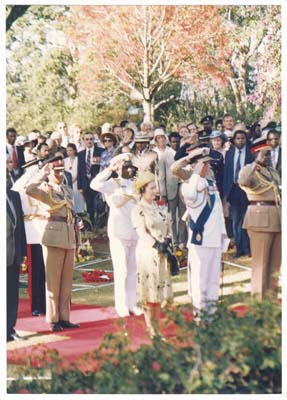
Nairobi War Cemetery, Kenya – November 1983
The contribution and sacrifices of East African men and women during both World Wars cannot be overlooked. The Nairobi War Cemetery, ensures thousands of East African service people are commemorated Almost 2,000 Commonwealth burials can be found here. Those with no known grave are remembered on the East Africa and Nairobi Memorials which sit within the Cemetery’s grounds. Her Majesty visited the site on the 18th of November 1983.
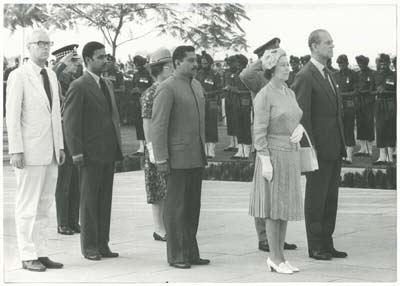
Delhi War Cemetery, India – November 1983
A week later, in India for the Commonwealth Heads of Government Meeting, The Queen and Prince Philip, accompanied by Shri K P Singh Deo, Minister of State for Defence, and senior officers of the Indian armed forces, visited Delhi War Cemetery to lay a wreath.
November is an important month for remembrance. Armistice Day takes place on the 11th with Remembrance Sunday falling on or close to that date. Other events, such as the Queen’s visits to Delhi and Nairobi, show how remembrance is not just restricted to one day. Indeed, at the CWGC, it is our ongoing mission.
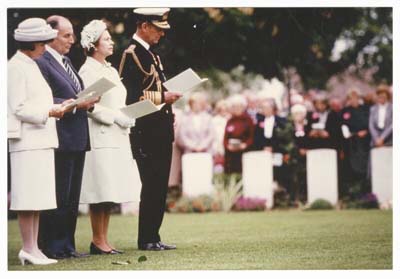
Delhi War Cemetery, India – November 1983
A week later, in India for the Commonwealth Heads of Government Meeting, The Queen and Prince Philip, accompanied by Shri K P Singh Deo, Minister of State for Defence, and senior officers of the Indian armed forces visited Delhi War Cemetery to lay a wreath.
November is an important month for remembrance. Armistice Day takes place on the 11th with Remembrance Sunday falling on or close to that date. Other events, such as the Queen’s visits to Delhi and Nairobi, show how remembrance isn’t just restricted to one day. Indeed, at the CWGC, it’s our ongoing mission.
On the anniversary day itself, The Queen laid wreaths at Bayeux War Cemetery before a crowd of relatives and former comrades who in their turn laid their flowers beside those of other Heads of State in attendance, or on individual graves or at the Memorial to the Missing. This Memorial, standing opposite the War Cemetery, bears the names of over 1,800 Commonwealth war dead who fell in the Battle of Normandy and have no known grave.
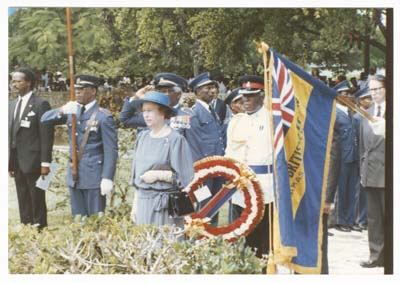
Nassau War Cemetery, The Bahamas – October 1985
In October 1985, Her Majesty, while in the Bahamas for a meeting of the Commonwealth Heads of Government, returned to Nassau War Cemetery to lead commemorations where 41 years earlier her uncle, then the Duke of Windsor and a former President of the Commission, had laid the cemetery’s foundation stone.
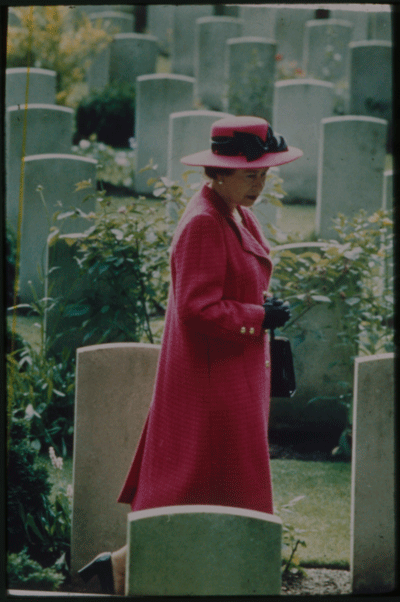
Arnhem Oosterbeek, Netherlands – July 1987
The Queen visited Arnhem Oosterbeek Cemetery as part of her tour of the Netherlands in 1987. Casualties from the Liberation of the Netherlands, particularly those who fought in Operation Market Garden are commemorated here, including around 1,750 Commonwealth Polish and Dutch burials.
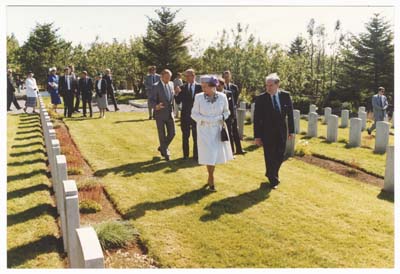
Fossvogur Cemetery, Iceland – June 1989
Iceland was occupied by the Allies during World War Two. Its strategic location made it the perfect naval base to help protect the vital Trans-Atlantic convoys. The occupation also helped deter any potential German invasion. Roughly 200 Commonwealth burials can be found at Fossvogur Cemetery, Reykjavik, which the Queen visited in June 1989 as part of a state visit to Iceland.
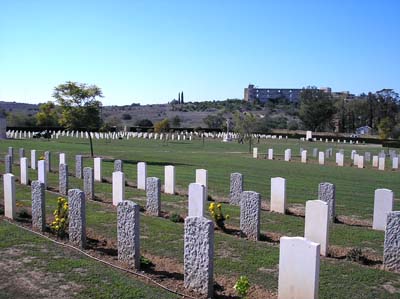
Nicosia Waynes Keep Military Cemetery, Cyprus – October 1993
This is one of the more unique sites the Commission tends to as it does not hold any World War casualties. Instead, Nicosia Waynes Keep Military Cemetery holds 600 non-World War casualties. It is in an interesting location too, situated in the UN buffer zone that stretches across Cypress. The Queen visited Wayne Keep while touring the island in October 1993.
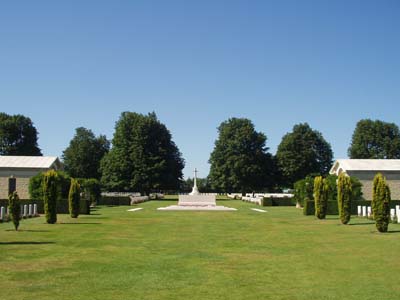
Normandy, France – June 1994
The 50th Anniversary of D-Day marked one of the most decisive actions of the Second World War. The Queen, alongside French and US Presidents Francois Mitterrand and Bill Clinton, led commemorations all over Normandy, including a service at Utah beach and visits to several Normandy cemeteries such as the one at Bayeux.
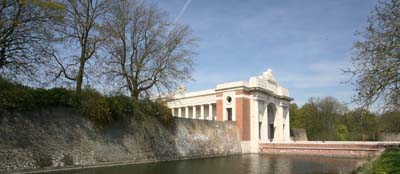
Menin Gate, Belgium – November 1998
80 years had passed since the guns fell silent on the Western Front in November 1998. A ceremony was held to mark the occasion with the Queen in attendance. Menin Gate was chosen as the site for a memorial as it was on this road that hundreds of thousands of soldiers made their way to the front across the Ypres Salient battlefronts throughout the First World War.
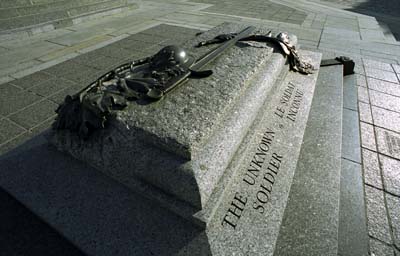
Ottawa National War Memorial – October 2002
Tombs of unknown soldiers or warriors are a tradition dating back to the First World War. They are symbolic monuments to all those who lost their lives fighting for their respective nations, past, present, and future. Canada’s own unknown soldier memorial sits at the feet of the Ottawa National War Memorial in the nation’s capital. Her Majesty visited the Monument in 2002 to lay a wreath on the unknown soldier’s tomb.
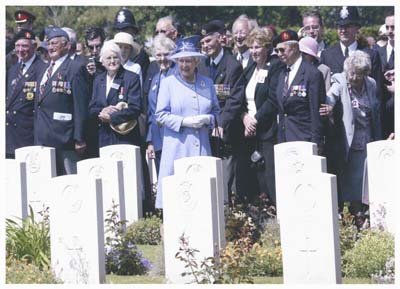
Normandy, France – June 2004
Her Majesty returned to Arromanches, Normandy in 2004, this time to mark the 60th Anniversary of the D-Day landings. Arromanches is where the British and Canadian sectors were located, covering Gold, Sword, and Juno beaches. Once again, The Queen toured the cemeteries of Normandy to remember those that gave their lives to free France and Europe in World War Two.
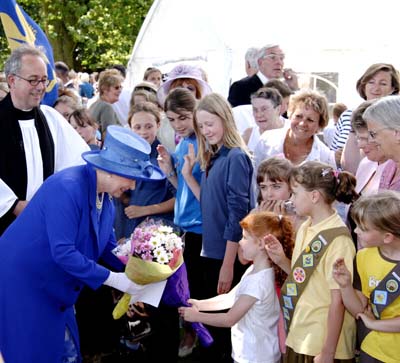
Great Bircham St Mary Churchyard, UK – July 2006
On 14th July 1946, His Majesty King George VI laid down the Cross of Sacrifice at the Great Bircham Cemetery in the Churchyard of St. Mary’s Church. Six decades later, The Queen attended a small ceremony to mark the Cemetery’s 60th anniversary. Nearly 80 Second World War burials, including Battle of Britain pilots of both sides, and a solitary Great War casualty, rest in peace in the picturesque Norfolk churchyard.
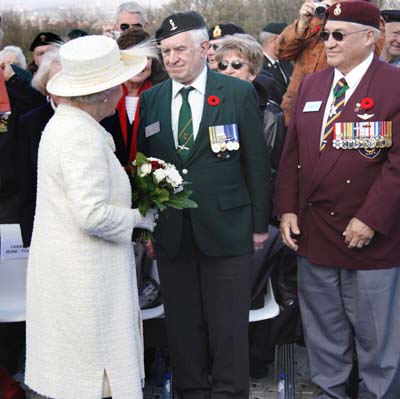
Vimy Memorial, France – April 2007
Vimy Ridge and the Canadians' heroic actions there have become legendary. The Canadian National Memorial at Vimy Ridge marks the spot of one of the key Canadian actions of World War One. Over 11,000 Canadian troops are commemorated here. At the Battle of Vimy Ridge’s 90th Anniversary, the Memorial was reopened to the public after a lengthy restoration project with the Queen in attendance.

Ypres/Menin Gate, Belgium – July 2007
Ypres and the Menin Gate stand as symbols of the tremendous battles for Belgium that occurred across the course of the great war. Her Majesty was part of a series of ceremonies here to mark the 90th Anniversary of the Battle of Passchendaele. The Queen also once again made a trip to Tyne Cot Cemetery during her visit to Belgium.
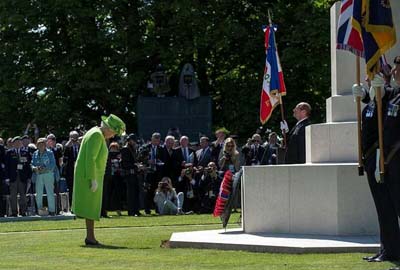
Normandy, France – June 2014
Another decade passing means another D-Day remembrance ceremony. 2014 saw 70 years since men and women came ashore on Normandy to help drive Axis forces out of mainland Europe. Once more, the Queen and the Duke of Edinburgh helped lead Normand commemorations with further trips to the Commission’s cemeteries in and around the region.
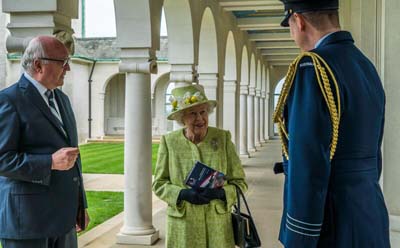
Runnymede, UK – March 2021
The Royal Australian Airforce celebrated its 100th birthday in March 2021. To mark this momentous milestone, Her Majesty visited the Runnymede Memorial. Nearly 1,500 Australians with no known grave are remembered across the Memorial’s various panels. They represent a generation of Australians that took to skies around the globe during World War Two but made the ultimate sacrifice.
To learn more about all the war memorials the Queen has visited over the years, and where you can visit them yourself, please head over to our Visit Us page.

